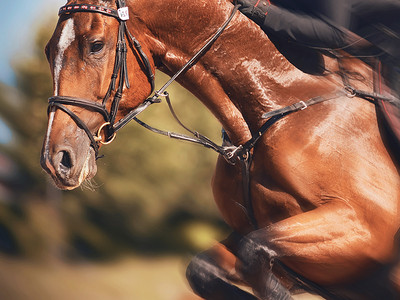 The Grand National is one of the most impressive spectacles in racing for the main reason that it offers such a challenge for both horses and riders. Even those that don’t regularly bet on the gee-gees tend to have a flutter when the National comes around, largely based on the idea that any of the horses can win. It’s not uncommon for punters to have a long-odds shot on their betting slip, just in case an outsider wins the race.
The Grand National is one of the most impressive spectacles in racing for the main reason that it offers such a challenge for both horses and riders. Even those that don’t regularly bet on the gee-gees tend to have a flutter when the National comes around, largely based on the idea that any of the horses can win. It’s not uncommon for punters to have a long-odds shot on their betting slip, just in case an outsider wins the race.
It’s happened a number of times over the years, mainly thanks to horses taking a fall on one of the tricky fences. It makes it as troublesome for bettors as it does exciting, given the fear that your horse could be one of the ones that fails to make it to the final stretch. Is there a particular fence that tends to cause the horses trouble when they’re trying to jump it? How many horses have fallen in recent history? They’re the sorts of questions we’ll look to answer here.
How Many Horse Fall in the Grand National?
Between 1984 and 2023, 311 horses fell whilst running in the Grand National. This is just over 21% of runners, or roughly 1 in every 5.
Becher’s Brook has the most fallers in this time with a total of 67 across both circuits. This fence alone accounts for almost a quarter of all fallers.
How Many Horses Fall?
The Grand National was first run in 1839, so it’s not unreasonable to suggest that a number of horses have fallen in the race over the years. It’s also not outrageous to say that looking as far back as the origins of the race probably isn’t all that useful in terms of modern day bettors looking to identify some key information ahead of the race. Instead, we’ll look at the race from 1984 to 2023 to give us a solid base of information to work with.
We’ve chosen to start looking at the information from 1984 onwards because that was the first year that the field was limited to 40 horses. Here’s a look how many of them fell in that year’s event and what the percentage of the total field that was.
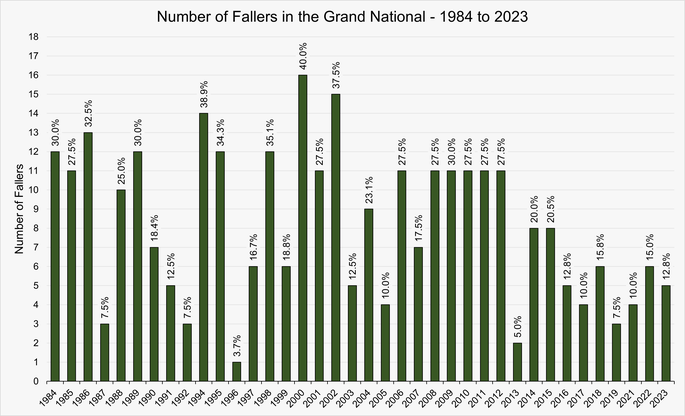
You can see, then, that the number of fallers in the Grand National varies wildly from year to year. The lowest number of fallers in a race was just one in 1996, Party Politics. The highest number of fallers was 16 in 2000.
Between 1984 and 2023, 311 horses fell. That works out as an average of around eight horses per race that have fallen over the years. Given that 1,475 horses have taken part in the race during that time, it works out as 21.1% of all horses that have fallen during the Grand National over the period of time that we’re investigating.
To put it another way, if you’re thinking of betting on a horse for the Grand National then you’ve got to bear in mind that your horse has got roughly a one in five chance of falling before they reach the finish line. It’s why a lot of bettors tend to have a wager on more than one horse in the Aintree event, often picking one with relatively short odds, one with slightly longer odds and one genuine outsider.
By opting for this method of betting, punters give themselves a decent chance of seeing at least one of their horses cross the finish line. It’s not a certainty, of course, and the nature of the race is such that there’s just as much chance that none of your horses could finish the race. That is both the beauty and the frustration of betting on the Grand National that has made it such a compelling event over the years.
How the Going Affects the Number of Fallers
With such variety between the number of fallers in any given Grand National, a key variable we can look at is the going on these occasions.
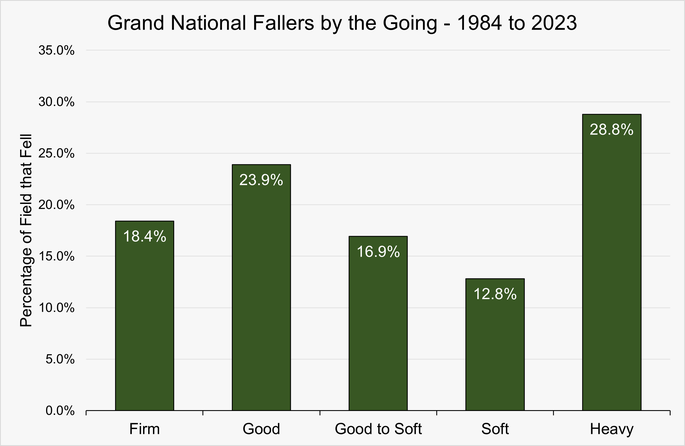
We can perhaps discount the percentages shown for Firm Going and also for Soft going. There has only been one race each on those ground conditions, giving a low sample volume. When looking at the going for the other races, we can see almost 29% of the field fall on average when running over Heavy going. This reduces to just under 17% on Good To Soft, rising to just under 24% on Good ground. This suggests that the ideal jumping conditions at Aintree is Good To Soft going.
Which Fences Take The Most Horses?
There aren’t many racecourses around the world that boast fences that have names that the majority of punters will recognise. That is very much the case with Aintree Racecourse however, with the Grand National being a race that has names that immediately spark the imagination. The likes of The Chair and The Canal Turn have evocative name, whilst many will know the story of Beecher’s Brook.
Grand National Named Fences
| Name | Fence Numbers |
|---|---|
| Westhead | 3 (1st circuit) & 19 (2nd circuit) |
| Becher’s Brook | 6 (1st circuit) & 22 (2nd circuit) |
| Foinavon | 7 (1st circuit) & 23 (2nd circuit) |
| Canal Turn | 8 (1st circuit) & 24 (2nd circuit) |
| Valentine’s | 9 (1st circuit) & 25 (2nd circuit) |
| Booth | 11 (1st circuit) & 27 (2nd circuit) |
| The Chair | 15 (1st circuit) |
| Water Jump | 16 (1st circuit) |
Just because a fence if famous doesn’t mean that it’s actually all that tricky for a horse to navigate, but there are certainly some that offer more of a challenge to the horses taking part in the Grand National than others. This is vital information that people wanting to bet in-play will want to know about when the Aintree race comes around, especially if a horse isn’t running very well and therefore looks like they might struggle with a challenging fence.
Here’s a closer look at those races that we’ve already explored, investigating which fences had horses fall during each running of the Grand National. Rather than put that information in a table, which would be far more complex, we’ve instead decided to pop it into a chart. At the end, we’ll collate the information about which fences have been the most troublesome during the 38 runnings of the event that we’re looking at.
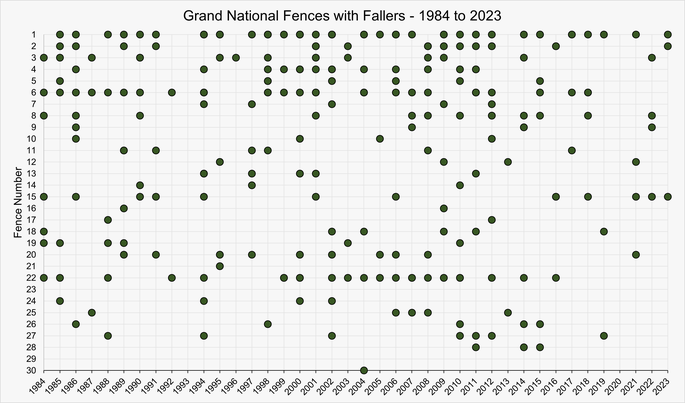
This chart shows that there is a concentration of fences where horse fall at the start of the race, between fences 1 and 6. This isn’t too surprising as there are more runners at the start of the race and many are yet to settle into the race. After this, the fences where there are fallers seems to remain quite consistent with the exception of fence 22 where there are regularly fallers. This fence is Becher’s Brook on the second circuit. There have been no fallers at fences 23 and 29 since 1984.
The Number of Fallers at Each Fence
It might seem as if some fences have had less fallers on them than others, but remember that earlier point that most of them are doubled up on the Grand National course. In fact, fences 15 and 16, The Chair and the Water Jump respectively, are the only ones that are jumped on just one occasion during the race. Some fallers might have been on the first circuit and some the second go around. The best way of breaking that down is by looking at the individual fences by their number, rather than by their name. Here’s how that breaks down for both circuits and in total.
Grand National Fallers by Fence – 1984 to 2023
| 1st Circuit | 2nd Circuit | Total | ||||||
|---|---|---|---|---|---|---|---|---|
| Fence | Fallers | Faller % | Fence | Fallers | Faller % | Fences | Fallers | Faller % |
| 1 | 60 | 19.29% | 17 | 2 | 0.64% | 1 & 17 | 62 | 19.94% |
| 2 | 20 | 6.43% | 18 | 6 | 1.93% | 2 & 18 | 26 | 8.36% |
| 3 | 16 | 5.14% | 19 | 7 | 2.25% | 3 & 19 | 23 | 7.40% |
| 4 | 15 | 4.82% | 20 | 12 | 3.86% | 4 & 20 | 27 | 8.68% |
| 5 | 7 | 2.25% | 21 | 2 | 0.64% | 5 & 21 | 9 | 2.89% |
| 6 | 40 | 12.86% | 22 | 27 | 8.68% | 6 & 22 | 67 | 21.54% |
| 7 | 5 | 1.61% | 23 | 0 | 0.00% | 7 & 23 | 5 | 1.61% |
| 8 | 14 | 4.50% | 24 | 4 | 1.29% | 8 & 24 | 18 | 5.79% |
| 9 | 7 | 2.25% | 25 | 5 | 1.61% | 9 & 25 | 12 | 3.86% |
| 10 | 6 | 1.93% | 26 | 6 | 1.93% | 10 & 26 | 12 | 3.86% |
| 11 | 6 | 1.93% | 27 | 6 | 1.93% | 11 & 27 | 12 | 3.86% |
| 12 | 5 | 1.61% | 28 | 3 | 0.96% | 12 & 28 | 8 | 2.57% |
| 13 | 8 | 2.57% | 29 | 0 | 0.00% | 13 & 29 | 8 | 2.57% |
| 14 | 3 | 0.96% | 30 | 2 | 0.64% | 14 & 30 | 5 | 1.61% |
| 15 | 15 | 4.82% | – | – | – | 15 | 15 | 4.82% |
| 16 | 2 | 0.64% | – | – | – | 16 | 2 | 0.64% |
Fence 15, also known as The Chair, is the race’s biggest obstacle, standing at five foot two inches high with a six foot ditch. Despite this fact it has claimed only 15 horses horses during the period that we’ve looked at, which is only the sixth most fallers.
The fence that has taken the most horses during the Grand National is fence 6, which also becomes fence 22 on the second circuit. Those that know the course won’t be surprised to learn that this is Becher’s Brook, arguably the most famous fence at Aintree Racecourse. No wonder it is such a feared obstacle by horses and jockeys alike. If a horse seems to be struggling approaching the 5th or 21st, they might not make it over fences 6 and 22.
Becher’s Brook is followed in the list of most fallers by the first fence, which doubles up as fence 17 on the second go around. Its main threat is that horses approach it too quickly after the race begins. An indication of this is that of the 62 fallers at that first fence, 60 are on the first circuit with just 2 on the second.
How Many Horses in Total Have Failed to Finish the Grand National?
In this article we’ve concentrated on horse which fall in the Grand National but that’s just one of the reasons why they might not finish the race. In total, out of the 1,475 runners in the National between 1984 and 2023, only 580 (39.3%) completed the race, whilst 895 (60.7%) failed to complete the course.
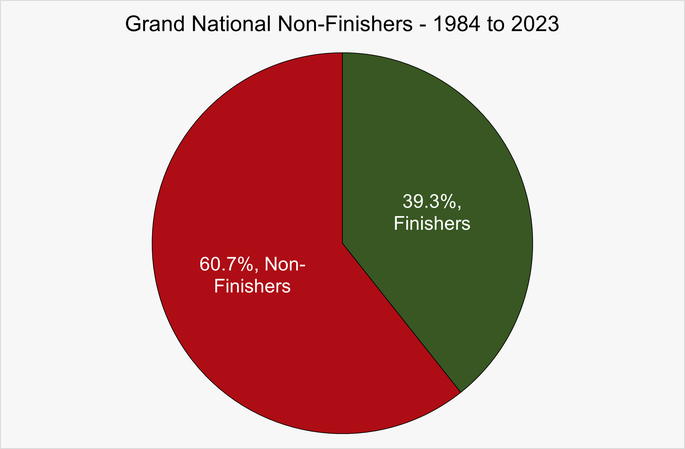
We already know that there were 311 fallers in this time, but what were the reasons for the remainder of the 895 non-finishers, 584 runners, being unable to reach the finish line.
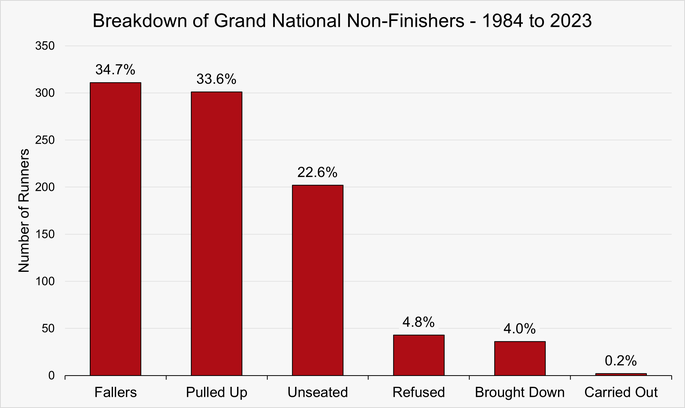
This chart shows that fallers make up the most non-finishers, with almost 35%. A narrow second with just under 34% (301) are horses that were pulled up by their jockeys either because of injury or to prevent injury. The third most frequent reason are horses that unseat their jockey without falling themselves, making up around 23% (202). These are the most frequent reasons however 43 horses refused to jump at a certain fence or at the start of the race, 36 runners were brought down by other fallers and 2 horses were carried of the course, following a loose horse who had lost their jockey. The most famous of the horses carried out was 9/1 shot Clan Royal in 2005, who was ridden by The Champ, Tony McCoy.
